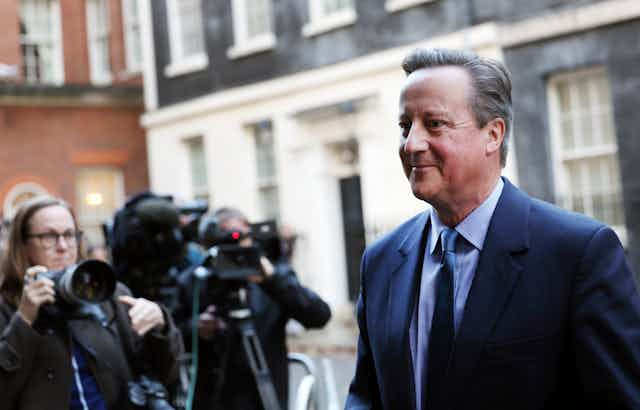Rishi Sunak’s decision to appoint former prime minister David (now Lord) Cameron as his foreign secretary has surprised and divided opinion, not least since Cameron left politics in 2016. It is not, however, without precedent for former prime ministers former to return to government.
There were five notable 20th century examples, two of whom also served as foreign secretary. All were brought back to provide experience and to encourage party (or coalition) unity.
That Cameron is the first ex-PM in almost 50 years to serve a successor perhaps relates more to the incumbent’s fear of being overshadowed. A predecessor only returns when they are no longer considered a threat.
Alec Douglas-Home: an experienced hand
Alec Douglas Home, who spent 363 days as head of government in 1963-1964, was the most recent example of a returning prime minister. He came back as foreign secretary in 1970 to serve under Edward Heath, one of his own former ministers. Douglas-Home was still an MP and was a former foreign secretary.

Heath had a purpose for appointing Douglas-Home, as his biographer, D.R. Thorpe later commented. The aim was to bring “a figure of ballast and stability in Heath’s administration”.
At a time when the prime minister was focused on negotiating Britain’s entry into the European Economic Community (the predecessor to the EU), having a foreign secretary capable of dealing with international affairs was useful.
Neville Chamberlain: backseat driver
The story of the early days of the second world war in Britain often revolves around the replacement of Neville Chamberlain by Winston Churchill on the very day Germany attacked France and the Low Countries. More often forgotten was that, until the month before his death in November 1940, Chamberlain served as lord president of the council in Churchill’s administration, sat in the war cabinet and remained as Conservative leader.
While remembered history has often centred on the rise of Churchill, Chamberlain’s continued presence demonstrated how limited the wartime premier’s powers initially were. He led a coalition government and was leader of neither party, while Chamberlain, an ex-premier whose leadership was tied to appeasement, remained in the cabinet.
The case shows how the inclusion of a former prime minister can sometimes allude to underlying weakness, rather than prime ministerial confidence.
Stanley Baldwin and Ramsay Macdonald: trading places
During the Great Depression of the 1930s, Britain’s experiment with national governments – coalitions of the major parties serving in the national interest – was dominated by the spectre and reality of former and current prime ministers serving under one another. Throughout Ramsay MacDonald’s second Labour government, there were questions over whether first world war leader David Lloyd George and his Liberals would form a coalition with Labour.
Lloyd George’s party had focused on promoting action on unemployment. His incapacity due to post-operation convalescence likely cost him a bigger role in the national government formed in August 1931.

However, while Lloyd George’s return never happened, the other key figure in MacDonald’s Conservative-dominated national government of 1931 to 1935 was Conservative leader (and two-time former prime minister) Stanley Baldwin. Serving as lord president of the council, Baldwin was a powerful deputy prime minister as his party made up the majority of government MPs.
Then Baldwin and MacDonald swapped roles. In 1935, Baldwin became prime minister once again and a much-weakened and increasingly unwell MacDonald returned to cabinet. He’d suffered a personal parliamentary defeat at the general election, survived thanks to a quickly rearranged by-election and returned as leader of the very junior coalition partner.
The interwar era provides two lessons. First, the widely held fears over a Lloyd George return to office reinforce how sitting prime ministers rarely like predecessors too close to the machinery of government.
Second, through Baldwin and MacDonald’s examples, we can see how belonging to the more powerful faction in either a coalition or one-party administration can enhance that politician’s effectiveness. Politics remains a competitive sport.
Arthur Balfour: global impact
The final, and perhaps most impactful ex-premier worth considering was Arthur Balfour. The nephew of Lord Salisbury – whose decision to appoint Balfour to a ministerial role was suggested to be the origin of the phrase “Bob’s your uncle” – he succeeded his uncle as Conservative prime minister in 1902. He then resigned in December 1905 in a political manoeuvre that led directly to the Liberal landslide in the 1906 election.
After being out of office for a decade, he returned to cabinet after the creation of a coalition government led by H.H. Asquith in 1915. His role was first lord of the admiralty, a major office as the Royal Navy was the world’s largest at the time. Yet he did not stop here.

After Lloyd George became prime minister in December 1916, Balfour was appointed foreign secretary (like Douglas-Home and Cameron) from then until 1919. He later served as lord of president of the Council twice (1919-22,1924-29).
At the Foreign Office he oversaw significant policy initiatives, including authoring his eponymous “Balfour Declaration” in 1917, which promised UK government support for a “national home for the Jewish people” within Palestine.
In this way, Balfour created one of the major problems his successor has inherited it today. Appropriately, Lord Cameron will deal with such issues from the House of Lords, which was once dubbed “Mr Balfour’s poodle” due to the Conservatives’ control over the upper chamber at the time.
The House of Lords serves a very different purpose today in revising legislation. That all of the above examples sat in the House of Commons, rather than the Lords, on their return shows that even among these former prime ministers recalled to serve, Cameron’s case is unusual.

